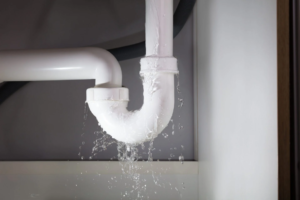You might not think about your home's pipes until there's a problem, but recognizing the signs of corrosion early can save you from costly repairs. Notice any discolored water or a sudden drop in water pressure? These could be red flags. Unusual tastes or odors in your water might also hint at corrosion. And what about those mysterious stains on your sinks or fixtures? They're not just unsightly; they might be warning signs. But don't stop there—there are more subtle indicators you should be aware of. Curious to know what else to watch for?
Key Takeaways
- Discolored water often indicates the presence of rust or corrosion in pipes.
- Low water pressure can be a sign of buildup or corrosion restricting water flow.
- Unusual tastes or odors in water may suggest corrosion affecting water quality.
- Staining on sinks or fixtures can result from corroded pipes leaching metals.
- Leaks or damp spots near pipes are common indicators of pipe corrosion.
Discolored Water
When you turn on your tap and notice that the water isn't crystal clear but has a brownish or reddish tint, it's a strong indicator of pipe corrosion. This change in color often results from rust particles flaking off the inside of your pipes and mixing with the water. Corroded pipes, especially those made of iron or steel, can lead to this unsightly discoloration, which not only looks unappealing but can also pose health risks if consumed over time.
You should act quickly if you observe this discoloration. Ignoring it might lead to further deterioration of the pipes, culminating in leaks or bursts that are costly and inconvenient to repair. Corroded pipes can also impart a metallic taste to your water, which is another sign that something's amiss. The discoloration might vary, showing up as a light rust color or a deeper reddish-brown, depending on the extent of the corrosion.
Decreased Water Pressure
Noticing a change in water clarity might also coincide with a drop in water pressure, another sign of pipe corrosion. When you turn on the faucet and the flow is weaker than usual, it's not just an inconvenience; it could indicate a serious plumbing issue. Corroded pipes can develop mineral build-up, which restricts the flow of water through your home's plumbing system. As these deposits accumulate, water struggles to pass through, causing a noticeable decrease in pressure.
You might find this especially frustrating during showers, when washing dishes, or filling up a bathtub. If you notice this decrease consistently across multiple fixtures, it's a strong hint that the issue lies within your pipes rather than a single faucet or showerhead.
Additionally, if the water pressure fluctuates between normal and low, this could be another clue pointing towards corrosion. Such inconsistency often suggests that the buildup is moving or breaking apart inside the pipes. Monitoring your water pressure can help you catch these signs early. Don't wait too long to investigate; addressing the problem sooner can prevent more extensive and costly damage down the road. Keep an eye out for these changes to maintain a healthy plumbing system.
Frequent Leaks
Frequent leaks in your plumbing system can be a telltale sign of pipe corrosion. When pipes corrode, they weaken over time, making them more vulnerable to developing leaks. As the corrosion progresses, it can create tiny holes or cracks in the pipe walls, allowing water to escape. This not only leads to annoying drips but also increases your water bill and can cause significant water damage to your home.
If you notice leaks occurring repeatedly, or in multiple locations, it's vital to take action. Ignoring these leaks can lead to more severe problems, such as burst pipes. Check areas of your home where pipes are visible, like basements or under sinks. Look for damp spots, water stains, or mold growth, as these can indicate ongoing leaks.
Don't just fix the leaks temporarily; addressing the underlying cause is paramount. Contact a professional plumber to assess the condition of your pipes. They can determine if corrosion is the issue and recommend appropriate solutions, like replacing affected sections of pipe or, in severe cases, repiping your home. Taking these steps promptly will help prevent further damage and maintain your plumbing system's longevity.
Unpleasant Odors
While addressing leaks is crucial, don't overlook the presence of unpleasant odors as another indicator of pipe corrosion. If you notice a persistent metallic or musty smell in your home, it might be a sign that your pipes are corroding. Corroded pipes can impact water quality, and these odors often originate from the water itself. As corrosion eats away at the pipes, tiny particles of rust and metal can mix with the water, releasing an unpleasant smell that's hard to disregard.
Bear in mind that these odors aren't just a nuisance; they might also indicate a more serious problem. Corroded pipes can lead to contaminated water, which poses health risks for you and your family. If you detect a distinct rotten egg smell, this could signal the presence of hydrogen sulfide gas, a byproduct of bacterial growth in corroded pipes.
To address this issue, inspect areas around sinks, drains, and other plumbing fixtures. If the smell becomes more pronounced when running water, it's time to contemplate an inspection by a professional plumber. Early detection of pipe corrosion will help prevent further damage and safeguard the safety of your home's water supply.
Noisy Pipes
A home's plumbing system can often communicate its distress through noisy pipes, a telltale sign of underlying corrosion issues. If you hear banging, clanking, or squealing sounds when you turn on the faucet, it could indicate that your pipes are suffering from corrosion. These noises occur because the metal inside the pipes is degrading, which can lead to irregular water flow and pressure changes.
The following table summarizes common pipe noises and their potential causes:
| Noise Type | Possible Cause |
|---|---|
| Banging | Water hammer, loose pipes |
| Clanking | Corroded pipe fittings |
| Squealing | Mineral deposits, narrowing |
| Rattling | Improper pipe support |
When pipes corrode, they can create air bubbles or change the water's natural flow, leading to the noises you hear. These sounds shouldn't be ignored, as they might signal that your pipes are close to leaking or bursting. You can take steps to investigate the source of the noise by checking exposed pipes in basements or under sinks. If you're unsure, it's always best to contact a professional plumber to assess the situation. Remember, addressing the issue early can prevent costly water damage and keep your home's plumbing system functioning smoothly.
Visible Rust
Another clear indication of pipe corrosion is visible rust, which you might notice on the exterior of pipes. When you're inspecting your plumbing, check for any reddish-brown spots or streaks. These are telltale signs that the metal is deteriorating. Rust forms when iron in the metal reacts with oxygen and moisture over time, which weakens the structural integrity of your pipes. Neglecting this can lead to severe damage, including leaks or even bursts, resulting in costly repairs.
Pay special attention to areas where pipes are exposed to moisture, like basements, bathrooms, or under sinks. These spots are more susceptible to rust formation. If you see rust, taking prompt action is crucial. You can either consult a plumbing professional or, for minor surface rust, try using sandpaper or a wire brush to gently remove it before applying a rust-inhibiting primer. However, if the rust seems extensive or if pipes are already leaking, replacement might be necessary.
Regular inspections can help you catch rust early. By staying vigilant, you can prevent further damage and maintain your plumbing system's efficiency, saving you from bigger headaches down the road.
Unusual Water Taste
An unmistakable sign of pipe corrosion is an unusual water taste, often described as metallic or bitter. If you notice your tap water tastes off, don't overlook it. This taste typically results from metals like iron, copper, or zinc leaching into your water supply due to deteriorating pipes. These metals not only impact taste but may also pose potential health risks over time if consumed in large quantities.
To determine if pipe corrosion is the culprit, start by checking the taste of water from different faucets in your home. If the unusual taste is present in multiple locations, it's likely a systemic issue with your plumbing. Additionally, inspect the water for any discoloration or particles, which can accompany the metallic taste.
Consider using a water testing kit to identify the presence of metals. These kits are available at most hardware stores and can provide insight into the specific contaminants affecting your water. If tests confirm metal presence, it's essential to contact a professional plumber. They'll assess the extent of corrosion and recommend solutions, such as replacing affected pipes or installing a water filtration system to secure safe, clean drinking water.

